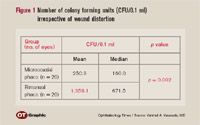Article
Microcoaxial incision technique may offer better wound integrity
Bimanual phacoemulsification wounds allow significantly greater ingress of fluid from the ocular surface compared with a microcoaxial incision. Even with the smallest of clear corneal incisions, wound integrity is critical. Surgeons should always look for incision distortion at the end of the case and should not hesitate to suture if necessary.

Key Points

At the annual meeting of the American Society of Cataract and Refractive Surgery, Vaishali A. Vasavada, MD, presented a rabbit model study evaluating intraocular contamination from ingress of a topically applied suspension containing Staphylococcus epidermidis. A clinical trial also was undertaken investigating wound integrity by assessing trypan blue ingress. Dr. Vasavada's co-authors were Devarshi U. Gajjar, PhD, Deepak Pandita, MS, Abhay R. Vasavada, MS, FRCS (England), and M.R. Praveen, DO, all affiliated with Iladevi Cataract & IOL Research Centre.
In both studies, all wounds allowed some ingress. Entry into the anterior chamber, however, was significantly greater in the eyes with the bimanual incisions.

Wound integrity
Dr. Vasavada cited several previous studies that indicated that wound integrity is a greater problem with the bimanual wounds.
"We have shown previously in rabbits that bimanual incisions are subject to greater collagen damage compared with incisions operated on through a sleeved tip, and concerns that bimanual incisions have greater propensity for wound stress, thermal injury, and wound distortion have been raised by Weikert and Koch," she said. "In addition, other investigators have demonstrated greater wound leakage and India ink penetration with bimanual incisions compared with microcoaxial incisions.
"However, those are cadaver studies, and to our knowledge, our trial in patients undergoing cataract surgery is the first randomized clinical trial that compares ingress of extraocular fluid with these two clear corneal incision techniques," said Dr. Vasavada.
The researchers first undertook the rabbit model study, and based on those findings, they went a step further and investigated ocular surface fluid ingress using trypan blue as a quantifying tracer.
The clinical trial randomly assigned 60 eyes of 60 patients to undergo bimanual or microcoaxial phacoemulsification. All procedures were performed by a single surgeon using standardized techniques. A clear corneal, 2.2-mm, single-plane incision was constructed for microcoaxial phaco. The bimanual procedure was performed using a 1.2-mm incision for the phaco tip and a 1.4-mm incision for the irrigating chopper; both were clear corneal, single-plane incisions.





